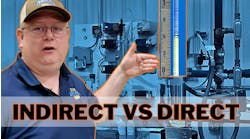Latest from Hydronics
Indirect vs. Direct Water Level Indicators Explained
Rapid Response Rescues Georgia Restaurant
Sponsored
WASHINGTON — U.S. Department of Energy Secretary Steven Chu in early April announced that the Department has finalized higher energy efficiency standards for a key group of heating appliances that will together save consumers up to $10 billion and prevent up to 164 million metric tons of carbon dioxide emissions over 30 years. The new standards, for residential water heaters, pool heaters and direct heating equipment such as gas fireplaces, will reduce air pollution, prevent the release of harmful nitrogen oxides and mercury, and avoid emissions equivalent to taking 46 million cars off the road for one year, DOE said.
The rules call for gas-fired storage water heaters at or less than 55-gal. to have an Energy Factor of 0.675, while those larger than 55-gal. would have an Energy Factor of 0.8012. Electric storage water heaters of 55-gal. or less would have an EF of 0.96 and those above 55-gal. would have an EF of 2.057. Oil-fired storage water heaters of all capacities would need an EF=0.68, while gas tankless units would need an EF=0.82.
The rules will take effect five years from now.
When DOE issued its Notice of Proposed Rulemaking late last year, water heater manufacturers told CONTRACTOR that the rules would create some challenges in design and manufacture.
The standards increase the stringency of the existing minimum conservation standards for these three types of residential heating products, which account for about 18% of energy use in homes across the country. The standards will significantly reduce energy consumption by these products, including decreasing energy use in large electric storage water heaters by 47% and by more than 30% in large gas water heaters.
At the time the standards were proposed, the executive director of Appliance Standards Awareness Project, an environmentalist group, said the rules did not go far enough.
“We’re disappointed that the Obama Administration has shied away from making even a modest first step to transition America to the most efficient types of water heaters,” Andrew deLaski said.
The American Council for an Energy Efficient Economy, however, had urged DOE to mandate much more stringent standards only for water heaters with capacities greater than 55-gal. Pushing advanced technologies on a small market segment would be a way to ease the transition to higher efficiencies into the rest of the water heater market, maintained ACEEE.
The final result was different than what was originally proposed. When the Notice of Proposed Rulemaking came out, the proposed rules call for gas-fired storage water heaters at or less than 60-gal. to have an Energy Factor of 0.675, while those larger than 60-gal. would have an Energy Factor of 0.717. DOE changed the cutoff point to 55-gal. and increased the Energy Factor for the larger water heaters. Electric storage water heaters of 80-gal. or less would have an EF of 0.96 and those above 80-gal. would have an EF of 1.088. DOE also changed that, making the cutoff capacity 55-gal. to match the gas water heater standard. It similarly increased the EF required for the larger units. The final rules for oil-fired storage water heaters of all capacities and gas tankless units remained unchanged from DOE’s original proposal.
The standards for water heaters will go into effect in 2015, while the standards for pool heaters and direct heating equipment — including gas-fired wall, floor and hearth heaters — will apply to products manufactured in 2013 and beyond.
Under the Obama Administration, the Department of Energy has accelerated the pace for finalizing new appliance standards and has placed new resources and emphasis behind the enforcement of these important standards. Since President Obama came to office, DOE has issued or codified new efficiency standards for more than 20 different products, which will save consumers between $250 and $300 billion on their energy bills through 2030.

